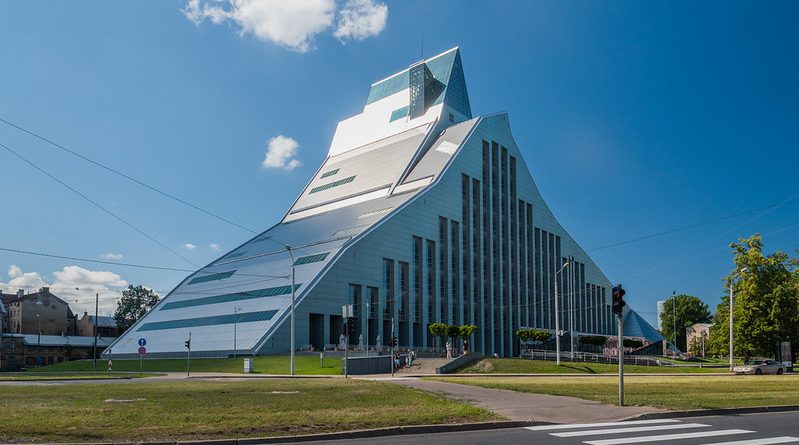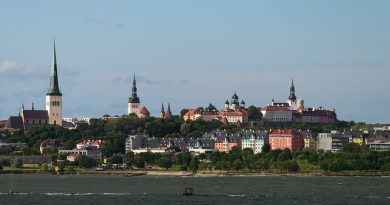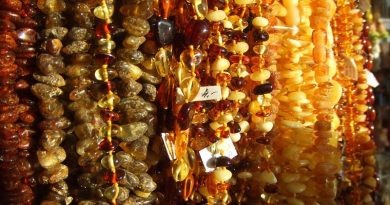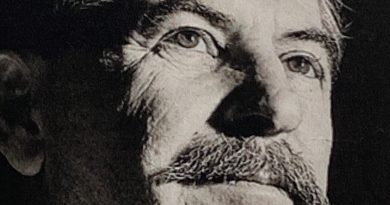The Most Beautiful Baltic Libraries & Bookshops
The Baltic countries – Estonia, Latvia and Lithuania – were chosen as this year’s Market Focus for the London Book Fair 2018, celebrating the centennial of their independent republics and introducing the exciting chance to discover epic past and vibrant, inventive present through the strong voice of modern literature. All book-loving travellers… here are some of the beautiful bookshops and libraries not to miss if you find yourself in the Baltics!
Lithuania
Nacionaline Biblioteka (National Library)
Founded in 1919, The National Library of Lithuania has seen the country through great changes. Just a few months after opening, Vilnius was occupied by the Polish legionaries and the library was closed for 9 months. Reopening at the end of that same year, it had already collected 18,000 volumes and by 1941 it held more than 200,000 books.
Following WW2, Lithuania was under Soviet Occupation and could only stock books in Russian that were printed in the USSR. Many Lithuanian and foreign books were destroyed as part of a campaign to rid the libraries of ‘harmful’ ideologies. When the Baltics reclaimed their independence in 1991, the library operations were completely transformed and in 2008 the building was renovated and expanded. Today, the marble temple-like structure offers 400 individual workstations and innovative spaces for non-traditional projects, communication, and creation.
Kauno Knygu Ministerija (bookshop)
This unique little spot in Kaunas wraps readers in the smell of coffee, the sound of the live piano and the spectacle of regular events. Champions of good books, they celebrate all authors from the little-known to bestsellers, and can order in any book issued in Lithuania to be delivered the next day – making them the real authority on Lithuanian literature! They also have a great selection of foreign language books so everyone can find something to immerse themselves whilst taking a coffee break.
Vilnius University Libraries
Vilnius University Library was founded by Jesuits in 1570 making it nine years older than the university and the oldest academic library in Lithuania. Found in the Old Town of Vilnius near the Presidential Palace of Lithuania, the library is a great tourist attraction bringing in 10,000 tourists every year. Of particular interest to tourists are the wood-panelled Hall of Pranciškus Smuglevičius covered in Classic paintings of the 12 most prominent figures in antique art and science, where exhibitions are frequently hosted, and the old observatory.
Estonia
The Estonian National Library
The National Library of Estonia was established as the parliamentary library of Estonia in 1918, making it the custodian of Estonian national memory and heritage. During the Soviet occupation the library was cut off from the international library network and many books were destroyed but it was given new life when Estonia re-established its independence in 1991. The eight-story building that now houses the library was built between 1985 and 1993, designed by Raine Karp and Sulev Vahtra, and is home to 20 reading rooms, a large conference hall, a theatre hall, many exhibition spaces and five million books.
The Rahva Raamat Bookstore
In 2004, the largest bookstore in Estonia, Rahva Raamat, opened in Viru Keskus. Over the years it has expanded across more floors, now making it the largest bookstore in the Baltic countries, with many kilometres of bookshelves spread over 1,600 m2 of space. This award-winning bookshop is well known for its events and signings – not to mention its two excellent cafes: Café Gustav and More – it was named one of the four best bookstores in the world at London Book Fair in 2016.
The Estonian Children’s Literature Centre
In a turreted fairy-tale building in the Old Town of Tallinn is the Estonian Children’s Literature Centre – a place where children and parents can discover books and reading in a vibrant, interactive setting. The centre features the Edgar Valter Gallery, Illustration Galleries and a Fairytale Attic dedicated to the mascot of the centre, Nukitsamees. They hold toddler hours, family sessions and display artwork and illustrations from both local and foreign artists
Latvia
National Library of Latvia in Riga
The National Library of Latvia, also known as the Castle of Light, was designed by the Latvian-American architect Gunnar Birkerts and built in 2008. It is inspired by a Latvian legend of the Castle of Light that sank into a lake and would only rise again once the Latvians reclaimed their land. The building is made up of 18 floors surrounded by glass and mirrors to amplify the rows of books, boasts a rooftop viewing platform and is open to the public for exhibitions. When the library was opened, 15,000 people joined the streets to create a book chain, passing 2,000 books hand-to-hand from the library’s old site to it’s new home. The library won the London Book Far Library of the Year Award 2018.
Mr Page (bookshop)
The Mr Page bookstore team carefully select a wide selection of books but have a real passion for books about the creative fields, popular science, popular culture, lifestyle and fiction from around the world. They especially look out for books that aren’t available in other Latvian bookshops and have created a space where readers can curl up in a window seat or perch at a table to flick through the books and find the right read for them. The whole store is a celebration of words, right down to the quotes stretching around the walls and the cluster of origami birds hanging from the ceiling that carry words on their wings.
Ventspils library
Ventspils Main Library began as an 18th century one-storey brick house in the city’s old town, near Saint Nickolai Church. It was extended in 1908 and has had various reconstructions since.
The latest incarnation of the building, opened in 2005, is a delicate marriage between the reconstructed part and the newly-built one, uses natural materials, and features steep double pitch roofs that are iconic of the old town architecture. The building was designed by Latvian architect Juris Poga and the interiors were styled by Vilmārs Terbets. A permanent exhibition of modern art is displayed in the building.




